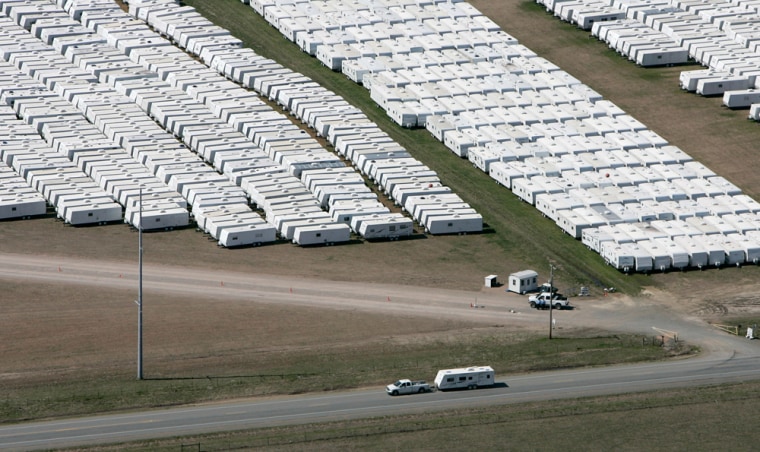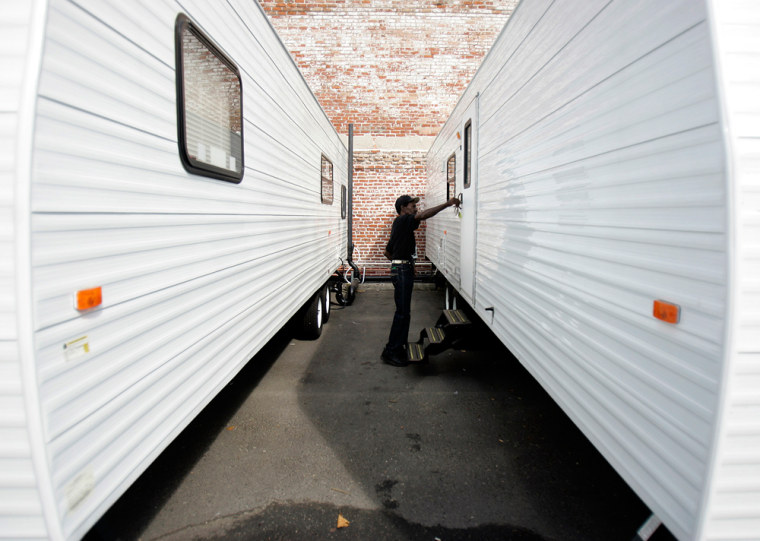The government may house disaster victims in trailers this hurricane season as a last resort, despite promises never to use them again because of high levels of formaldehyde found in trailers used after the Katrina catastrophe.
Only the head of the Federal Emergency Management Agency could approve the use of such trailers, and they would have to meet the agency's standard for low formaldehyde levels, according to a draft of the agency's five-page 2008 hurricane-season plan, obtained by The Associated Press. Also, disaster victims could stay in the trailers for only six months.
Hurricane season started June 1 and will last through November. Forecasters predict the 2008 Atlantic season will be busier than average, with a good chance of six to nine hurricanes forming, including two to five major ones.
The Bush administration and FEMA came under heavy criticism for the response to Katrina in 2005. About 1 million people were displaced because of the hurricane, and thousands were sent to emergency travel trailers. It was later discovered that the trailers had high levels of formaldehyde — a preservative commonly used in building materials. Prolonged exposure can lead to breathing problems and is also believed to cause cancer.
Health complaints
Complaints began popping up shortly after Hurricanes Katrina and Rita, with residents of FEMA-issued trailers reporting frequent headaches, nosebleeds and other ailments.
Currently some 500 families remain in trailers, according to FEMA.
FEMA Director R. David Paulison has said there will be no more trailers while he is in office. But his deputy says that's not a sure thing, should there be another catastrophic disaster.
"We're putting our head in the sand," deputy administrator Harvey Johnson said in an interview Monday. "If we had a Katrina again, there's probably no way we could respond to a Katrina without having to deploy all available options, which will include travel trailers."
For the 2008 season, FEMA is also prepared to use "Katrina Cottages," which are small houses, slightly larger than a trailer, as well as mobile homes and park models. The agency is testing other alternatives and will draw up contracts to purchase additional units once officials decide which models to use.
FEMA would also ask a disaster-stricken state to decide which disaster housing unit it wants to use. And it would ask communities to decide where they want the units. This reinstates previous roles of states and the federal government, Johnson said.
Any unit FEMA provides will be tested for formaldehyde before being deployed.
There is no industry standard for the amount of formaldehyde in travel trailers. The government sets standards for indoor air quality for materials used to build mobile homes, but not for travel trailers.

Until experts determine a safer level of the preservative, FEMA has set its own standard at 16 parts formaldehyde per billion parts of air. Late last year, the Centers for Disease Control and Prevention tested 358 travel trailers, 82 park models and 79 mobile homes. The CDC found average levels of 77 parts formaldehyde per billion parts of air, significantly higher than the 10 to 17 parts per billion concentration seen in newer homes. Levels were as high as 590 parts per billion.
The draft of the 2008 hurricane disaster housing plan also emphasizes a need for FEMA to try to immediately repair damage to homes to make them habitable until more permanent repairs can be done. If a home is damaged or destroyed, FEMA will provide financial assistance, and the agency will work with community groups to find available rental properties. Some displaced victims could be eligible for temporary hotel and motel funding assistance.
More studies needed
But there should be more scientific studies to determine what are suitable housing units for disaster victims, said Raul Bencomo, an attorney for the hundreds of trailer occupants in Mississippi and Louisiana who are suing companies that manufactured the units for FEMA after hurricanes Katrina and Rita.
"The government is in a quandary because they really don't have enough housing to be able to deploy safe housing in a major catastrophe," Bencomo said Monday.
The House Homeland Security Committee is holding a hearing Wednesday on housing plans for this hurricane season.
"It troubles me that three years after Katrina, FEMA has yet to come up with legitimate alternatives to travel trailers," Rep. Bennie Thompson, D-Miss., said.
"This is just another Band-Aid and another example of them kicking the can down the road and not producing the comprehensive disaster housing strategy the country needs," said Stephanie Allen, spokeswoman for Sen. Mary Landrieu, D-La. Landrieu chairs the Senate subcommittee that has oversight of disaster housing.
Understanding formaldehyde risksFormaldehyde is classified as a probable carcinogen, or cancer-causing substance, by the Environmental Protection Agency. There is no way to measure formaldehyde in the bloodstream. Respiratory problems are an early sign of exposure.
Young children are at particular risk. Thousands who lived in trailers will be in the prime of life in the 10 to 15 years that doctors believe it takes cancer to develop.
FEMA and CDC reports so far have drawn criticism.
A CDC study released May 8 examined records of 144 Mississippi children, some of whom lived in trailers and others who did not. But the study was confined to children who had at least one doctor's visit for respiratory illness before Katrina. It was largely inconclusive, finding children who went to doctors before the August 2005 storm were still visiting them two years after.
A bigger, five-year CDC study will include up to 5,000 children in Louisiana, Mississippi, Alabama and Texas, and CDC officials said it should begin next year. But members of Congress point to the decade or longer it could take for cancer to develop and say a five-year look is inadequate.
"Monitoring the health of a few thousand children over the course of a few years is a step in the right direction, but we need commitment," said Rep. Bennie Thompson, D-Miss.
Thompson has introduced legislation to force FEMA and CDC to provide health exams for trailer residents who believe formaldehyde made them ill. The bill is similar to $108 million legislation for workers who labored at the World Trade Center site.
